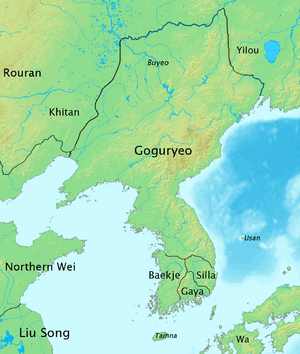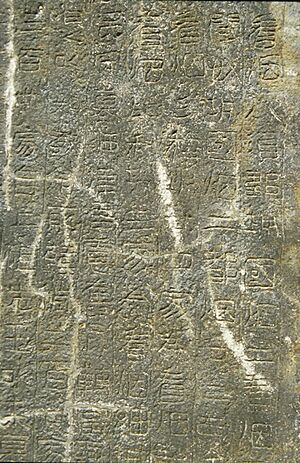Gwanggaeto the Great facts for kids
| Emperor Gwanggaeto the Great | |
| Hangul |
광개토태왕
|
|---|---|
| Hanja |
廣開土太王
|
| Revised Romanization | Gwanggaeto-taewang |
| McCune–Reischauer | Kwanggaet'o-taewang |
Quick facts for kids Birth name |
|
| Hangul |
고담덕
|
| Hanja |
高談德
|
| Revised Romanization | Go Damdeok |
| McCune–Reischauer | Ko Tamdǒk |
| Posthumous name | |
| Hangul |
국강상광개토경평안호태왕
|
| Hanja |
國岡上廣開土境平安好太王
|
| Revised Romanization | Gukgangsang-gwanggaetogyeong-pyeongan-hotaewang |
| McCune–Reischauer | Kukkangsang-kwanggaet'ogyŏng-p'yŏngan-hot'aewang |
Gwanggaeto the Great (born 374, died 413, ruled from 391 to 413) was a powerful king of Goguryeo. Goguryeo was one of the Three Kingdoms of Korea. His full special name, given after he died, means "King who expanded the land and brought peace." People sometimes call him Hotaewang for short.
Gwanggaeto chose the name Yeongnak for his time as ruler. This name meant "Eternal Rejoicing." He also used the title Taewang, which means "Supreme King" or "Emperor." This showed that Goguryeo was as powerful as the big empires in China.
Under Gwanggaeto, Goguryeo had a golden age. It became a strong empire and one of the most important powers in East Asia. Gwanggaeto made huge gains and conquered many lands. He expanded into:
- Western Manchuria, fighting against Khitan tribes.
- Inner Mongolia and the Maritime Province of Russia, taking on many different groups.
- The Han River valley in central Korea.
He ended up controlling more than two-thirds of the Korean peninsula.
In Korea, Gwanggaeto defeated Baekje, which was the strongest of the Three Kingdoms of Korea at that time. This happened in 396. He captured their capital city, Wiryeseong, which is now part of Seoul. In 399, Silla, another kingdom in the southeast, asked Goguryeo for help. Baekje troops and their allies from Japan, called Wa, were attacking Silla. Gwanggaeto sent 50,000 soldiers. They crushed his enemies and made Silla a protected area under Goguryeo's influence. This way, he brought the Korean kingdoms together loosely under Goguryeo.
In his western wars, he defeated the Xianbei people from the Later Yan empire. He also conquered the Liaodong peninsula, getting back old lands of Gojoseon.
Gwanggaeto's great achievements are written on the Gwanggaeto Stele. This is a large stone monument built in 414. It stands near where his tomb is thought to be, in Ji'an, Jilin, close to the China–North Korea border. His son and the next king, Jangsu, built this monument. It is the biggest engraved stone monument in the world.
Contents
Early Life and Goguryeo's Situation
At the time Gwanggaeto was born, Goguryeo was not as strong as it used to be. In 371, just three years before Gwanggaeto's birth, a rival Korean kingdom called Baekje defeated Goguryeo. This was under the leadership of King Geunchogo. Baekje killed Goguryeo's king, Gogukwon, and attacked Pyongyang. Baekje then became one of the most powerful states in East Asia.
Baekje's power reached beyond the Korean peninsula. It spread across the sea to parts of China like Liaoxi and Shandong. This happened because the Former Qin state in China was weak. Baekje's influence also reached Kyūshū in Japan. Goguryeo tried to avoid fights with Baekje. Instead, they focused on building good relationships with other groups like the Former Qin, the Xianbei, and the Rouran. This helped them defend against future attacks and gave them time to improve their laws and military.
King Gogukwon's son, Sosurim, became the next king. He chose to make peace with Baekje. He also focused on making changes inside Goguryeo. He spread Buddhism throughout the kingdom. Sosurim also made important changes to the military. This was to prevent the kind of defeats Goguryeo had suffered before. These changes by Sosurim prepared Goguryeo for Gwanggaeto's later expansion.
Sosurim's successor, Gogukyang, attacked Later Yan in 385. Later Yan was a state that came after Former Yan. Gogukyang also attacked Baekje in 386.
Gwanggaeto's Time as King
Becoming King and Wars with Baekje
Gwanggaeto became king after his father, Gogukyang, died in 391. When Gwanggaeto was crowned, he chose the era name Yeongnak (Eternal Rejoicing). He also took the title Taewang (Supreme King). This title was like "emperor" and showed he saw himself as equal to the rulers of China.
In 392, Gwanggaeto led an attack on Baekje with 40,000 soldiers. They captured 10 walled cities. In return, King Asin of Baekje attacked Goguryeo in 393 but was defeated. Even with the war going on, Gwanggaeto built 9 Buddhist temples in Pyongyang in 393. King Asin attacked Goguryeo again in 394 but lost once more.
After many defeats against Goguryeo, Baekje's government started to weaken. In 395, Goguryeo defeated Baekje again. Baekje was pushed south to its capital, Wiryeseong, which was on the Han River. The next year, in 396, Gwanggaeto attacked Wiryeseong by land and sea, using the Han River. He won against Baekje. Gwanggaeto captured the Baekje capital. The defeated King Asin gave up to Gwanggaeto, handing over a prince and 10 government officials.
Northern Expansion
In 395, while fighting Baekje in the south, Gwanggaeto also attacked the Khitan Baili clan in the west. This was near the Liao River. He destroyed 3 tribes and between 600 and 700 camps. In 398, Gwanggaeto conquered the Sushen people to the northeast. These people were ancestors of the Jurchens and Manchus.
In 400, while Gwanggaeto was busy with Baekje, Gaya, and Wa troops in Silla, the Xianbei state of Later Yan attacked Goguryeo. Later Yan was founded by the Murong clan in what is now Liaoning. Gwanggaeto pushed back the Xianbei troops. In 402, Gwanggaeto fought back and conquered a strong fortress near Later Yan's capital. In 405 and again in 406, Later Yan troops attacked Goguryeo fortresses in Liaodong. But they were defeated both times. Gwanggaeto conquered all of Liaodong. By taking Liaodong, Gwanggaeto got back the old lands of Gojoseon. Goguryeo controlled Liaodong until the middle to late 600s.
In 407, Gwanggaeto sent 50,000 soldiers, both foot soldiers and horse riders. They won a big victory, completely destroying the enemy. They took about 10,000 armors and many war supplies. The enemy could have been Later Yan, Baekje, or Wa.
In 410, Gwanggaeto attacked Eastern Buyeo to the northeast.
Southern Wars
In 400, Silla, another Korean kingdom, asked Goguryeo for help. They needed help fighting off an attack by Baekje, Gaya, and Wa. Gwanggaeto sent 50,000 soldiers and wiped out the enemy group. After this, Gwanggaeto had a lot of power over Silla. Gaya became weaker and never fully recovered. In 402, Gwanggaeto sent Prince Silseong back home to Silla. Silseong had been living in Goguryeo as a political guest since 392. Gwanggaeto then made him the king of Silla.
In 404, Gwanggaeto defeated an attack by the Wa from Japan. This attack was on the southern border of what used to be the Daifang commandery. Gwanggaeto's forces caused huge losses to the enemy.
Death and What He Left Behind
Gwanggaeto died in 413 at the age of 39 from an unknown sickness. His oldest son, Jangsu, became the next king. Jangsu ruled Goguryeo for 79 years, until he was 98 years old. This was the longest rule in East Asian history.
Gwanggaeto's victories are seen as the peak of Korean history. He built a large empire in Northeast Asia and brought the Three Kingdoms of Korea under his influence. Gwanggaeto conquered 64 walled cities and 1,400 villages. Except for the 200 years that followed, when Jangsu built on his father's lands, and the golden age of Balhae, Korea has never ruled such a large area. There is also proof from old sites that Goguryeo's lands reached even further west into what is now Mongolia. This is based on discoveries of Goguryeo fortress ruins there. Gwanggaeto created his own era name, Yeongnak Eternal Rejoicing. This showed that Goguryeo's kings were equal to the rulers in China.
Gwanggaeto the Great is one of only two Korean rulers whose names include "the Great." The other is Sejong the Great of Joseon. Sejong created Hangul, the Korean alphabet, to help common people learn to read. He also made big advances in science.
Koreans see Gwanggaeto as one of the greatest heroes in Korean history. He is often a strong symbol of Korean nationalism.
The Gwanggaeto Stele is a monument that is 6.39 meters tall. Jangsu built it in 414. It was found again in the late 1800s. The stele has information about Gwanggaeto's rule and achievements. However, not all the words and parts of the text are still clear. Korean and Japanese experts have different ideas about how to understand the parts that talk about the Wa.
The Republic of Korea Navy has ships called Gwanggaeto the Great-class destroyers. These ships were built by Daewoo Heavy Industries and are named to honor the king.
A large statue of Gwanggaeto and a copy of the Gwanggaeto Stele were put up on the main street of Guri city in Gyeonggi province.
Gwanggaeto in Pop Culture
Movies and TV Shows
- He was played by Yoo Seung-ho and Bae Yong-joon in the 2007 MBC TV show The Legend.
- He was played by Lee Tae-gon in the 2011-2012 KBS1 TV show Gwanggaeto, The Great Conqueror.
- Lee Do-yeob played him in the 2017 KBS1 docudrama Chronicles of Korea.
Books and Games
Many novels, comic books, and games about Gwanggaeto the Great have been released in Korea.
The popular mobile game Hero for Kakao features Gwanggaeto as a character you can play.
Age of Empires: World Domination, a mobile game made with Microsoft, includes Gwanggaeto as a hero for the Korean civilization.
Other Tributes
The International Taekwon-Do Federation created a special pattern, or teul, to honor Gwanggaeto the Great. The pattern's design shows how Gwanggaeto expanded his land and got back lost areas. The 39 moves in the pattern represent the first two numbers of 391 AD, which is the year Gwanggaeto became king.
See also
 In Spanish: Gwanggaeto el Grande de Goguryeo para niños
In Spanish: Gwanggaeto el Grande de Goguryeo para niños



